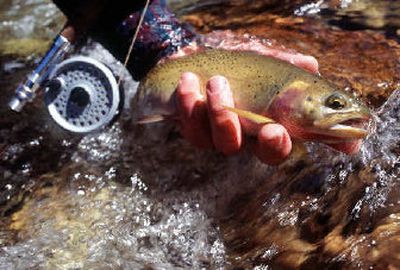Cutthroat business in Bob Marshall Wilderness

Plans to poison thousands of fish in 21 Montana lakes then stock them with westslope cutthroat trout have final approval and the work, still disputed by some state commissioners, is tentatively scheduled to start this fall.
The project, proposed in 2001, is meant to remove hybrid trout from the western Montana lakes, nearly half of them in the Bob Marshall Wilderness.
Genetically pure westslope cutthroat, the state fish, have been reduced to about 9 percent of their historic range and are threatened by hybrids, the Montana Department of Fish, Wildlife and Parks said. Westslope cutthroat are classified as a “species of special concern” in Montana, and state officials say they want to prevent the fish from requiring protection under the federal Endangered Species Act.
Jim Satterfield Jr., regional administrator for Fish, Wildlife and Parks in Kalispell, signed the agency’s decision supporting the 10-year project in the South Fork Flathead River area.
The U.S. Forest Service and the federal Bonneville Power Administration also signed off on the project, after an environmental analysis, 22 public meetings and a public-comment period.
However, conservation groups have challenged a plan to eradicate hybrid fish from alpine lakes in the South Fork Flathead River drainage.
In June, Wilderness Watch and Friends of the Wild Swan filed an appeal of the Flathead National Forest’s decision authorizing the cutthroat trout conservation program.
Fish, Wildlife and Parks plans to use rotenone or antimycin to poison fish, moving the treatment from one lake to another until all 21 have received chemicals by the end of the 10 years. The lakes would be stocked with hatchery-raised westslope cutthroat, on a schedule intended to meet the needs of anglers, spokesman John Fraley said.
Most of the dead fish would be left in the waters to decay, he said.
Other chemical projects in Montana waters include one at Cherry Creek, which flows through media magnate Ted Turner’s Flying D Ranch in southern Montana.
Turner is largely financing that $500,000 project, which survived court challenges and aims to remove nonnative fish, then reintroduce westslope cutthroat trout. The project began several years ago. Fish, Wildlife and Parks expects the final chemical treatment to occur in 2008 or 2009.
The latest project, called the South Fork Flathead Watershed Westslope Cutthroat Trout Conservation Program, was disputed in April by some members of the Fish, Wildlife and Parks Commission.
Commissioner Victor Workman of Whitefish said the project is risky, based on inadequate information and aims for an unattainable level of fish purity. Fish, Wildlife and Parks staff has acknowledged the project holds some uncertainties, but said that on balance, it should proceed.
“This is a tool that has been shown to work,” staff member Brian Marotz told commissioners. “If this isn’t the place to drive the lance for the species, then there isn’t one left in Montana.”
Commissioner Shane Colton of Billings said at the April meeting that he is not enthused about the chemical project, but “I don’t want to be the guy sitting here saying we did nothing because we didn’t understand the science.”
In the 48 contiguous states, the South Fork Flathead is perhaps the last stronghold for westslope cutthroat trout, Satterfield said.
For the Forest Service, which manages the Jewel Basin, Bob Marshall Wilderness and some other lands surrounding the lakes, consideration of the project included evaluating the use of chemicals and mechanized equipment in the wilderness. Motorized or mechanical equipment ordinarily is not allowed in wilderness areas.
“Whatever the need may be, we’re open to that for this particular project, such as helicopter use, an airplane, motorized boats,” said Denise Germann, spokeswoman for the Flathead National Forest.
In their appeal, the groups allege violations of the Wilderness Act, National Environmental Policy Act, National Forest Management Act and Endangered Species Act.
“Our organizations want to see the native cutthroat trout protected in a way that also protects the wilderness character of the Bob Marshall and all the wildlife that live in and around its lakes and streams,” said George Nickas, executive director of Wilderness Watch. “This plan emphasizes westslope cutthroat at the expense of everything else, and that’s just not consistent with what wilderness is all about.”
The appeal also said the use of helicopters, aircraft, outboard motors, pumps and mixers in the Jewel Basin and Bob Marshall violates the Flathead Forest Plan’s ban on motorized equipment in grizzly bear core areas while bears are out of their dens.
The Bonneville Power Administration will provide money for the fish project through a program intended to mitigate effects of the federal Hungry Horse Dam in northwestern Montana. The budget has not been set, BPA’s Ed Mosey said.